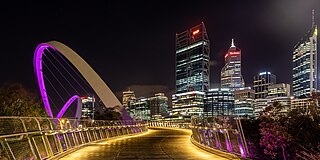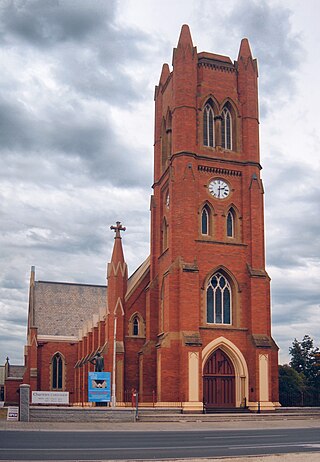
The Liberty Bell, previously called the State House Bell or Old State House Bell, is an iconic symbol of American independence located in Philadelphia. Originally placed in the steeple of Pennsylvania State House, now known as Independence Hall, the Liberty Bell today is located across the street from Independence Hall in the Liberty Bell Center in Independence National Historical Park.

The Church of St Mary the Virgin, widely known as St Mary Redcliffe, is the main Church of England parish church for the Redcliffe district of the city of Bristol, England. The first reference to a church on the site appears in 1158, with the present building dating from 1185 to 1872. The church is considered one of the country's finest and largest parish churches as well as an outstanding example of English Gothic architecture. The church is so large it is sometimes mistaken for Bristol Cathedral by tourists. The building has Grade I listed status, the highest possible category, by Historic England.

The Whitechapel Bell Foundry was a business in the London Borough of Tower Hamlets. At the time of the closure of its Whitechapel premises, it was the oldest manufacturing company in Great Britain. The bell foundry primarily made church bells and their fittings and accessories, although it also provided single tolling bells, carillon bells and handbells. The foundry was notable for being the original manufacturer of the Liberty Bell, a famous symbol of American independence, and for re-casting Big Ben, which rings from the north clock tower at the Houses of Parliament in London.

St Paul's Cathedral is an Anglican cathedral in Melbourne, Australia. It is the cathedral church of the Diocese of Melbourne and the seat of the Archbishop of Melbourne, who is also the metropolitan archbishop of the Province of Victoria.

The Cathedral Church and Minor Basilica of Saint Patrick is the cathedral church of the Roman Catholic Archdiocese of Melbourne in Victoria, Australia, and seat of its archbishop, currently Peter Comensoli.

First Church is a prominent church in the New Zealand city of Dunedin. It is located in the heart of the city on Moray Place, 100 metres to the south of the city centre. The church is the city's primary Presbyterian church. The building is regarded as the most impressive of New Zealand's nineteenth-century churches, and is listed by Heritage New Zealand as a Category I structure.

Barrack Street is one of two major cross-streets in the central business district of Perth, Western Australia. Together with St Georges Terrace, Wellington Street and William Street it defines the boundary of the main shopping precinct of the central city.

St George's Cathedral is the principal Anglican church in the city of Perth, Western Australia, and the mother-church of the Anglican Diocese of Perth. It is located on St Georges Terrace in the centre of the city.

Elizabeth Quay is a mixed-use development project in the Perth central business district. Encompassing an area located on the north shore of Perth Water near the landmark Swan Bells, the precinct was named in honour of Queen Elizabeth II during her Diamond Jubilee.

Tourism in Perth, the capital city of Western Australia, is an important part of the Australian state's economy, contributing to the prosperity of businesses in the city, as well as other regions of the state.

St Edmund's Church, Southwold is a Grade I listed parish church in the Church of England in Southwold, Suffolk.
The Royal Jubilee Bells are a set of eight bells that were cast for the church of St James Garlickhythe in the City of London, which were seen on television around the world leading the Thames Diamond Jubilee Pageant on 3 June 2012 for the Diamond Jubilee of Elizabeth II.

St Paul's Cathedral, Bendigo, is an Anglican cathedral church in Bendigo, Victoria, Australia. It is the cathedral church of the Diocese of Bendigo and the seat of the Bishop of Bendigo, presently Matthew Brain.

St Bartholomew's Church, Burnley, is the Anglican parish church of the small suburb of Burnley, historically considered part of Richmond, in inner-suburban Melbourne, Victoria, Australia. Known colloquially as "St Bart's", the parish is in the Anglican Diocese of Melbourne and is well known as belonging to the Anglo-Catholic or High Church tradition. Its congregation is active in various ministries around Richmond and beyond. It has an opportunity shop which operates out of the parish hall.
The Elizabeth Quay Jetty is located at the western side of Elizabeth Quay inlet on the Swan River in Perth, Western Australia.

St Patrick's Church is a Church of Ireland church, located on Castle Street, Ballymena, Northern Ireland. It is the main Parish Church in Ballymena's Anglican parish of Kirkinriola and Ballyclug, and is the main civic church of the town. The current church replaced an older church dating from the early 18th century on Church Street, and was opened in 1855. The new church was destroyed by fire in December 1879, and it was restored by the original builder, keeping to the same design. It reopened in 1881.

The All Saints Cathedral Bells are heritage-listed church bells at All Saints Anglican Cathedral, Church Street, Bathurst, Bathurst Region, New South Wales, Australia. They were built from 1853 to 1855 by John Warner and Sons, Crescent Foundry of London, England. They were added to the New South Wales State Heritage Register on 10 September 2004.
Campanology is the scientific and musical study of bells. It encompasses the technology of bells – how they are cast, tuned, and rung – as well as the history, methods, and traditions of bellringing as an art. Articles related to campanology include:























